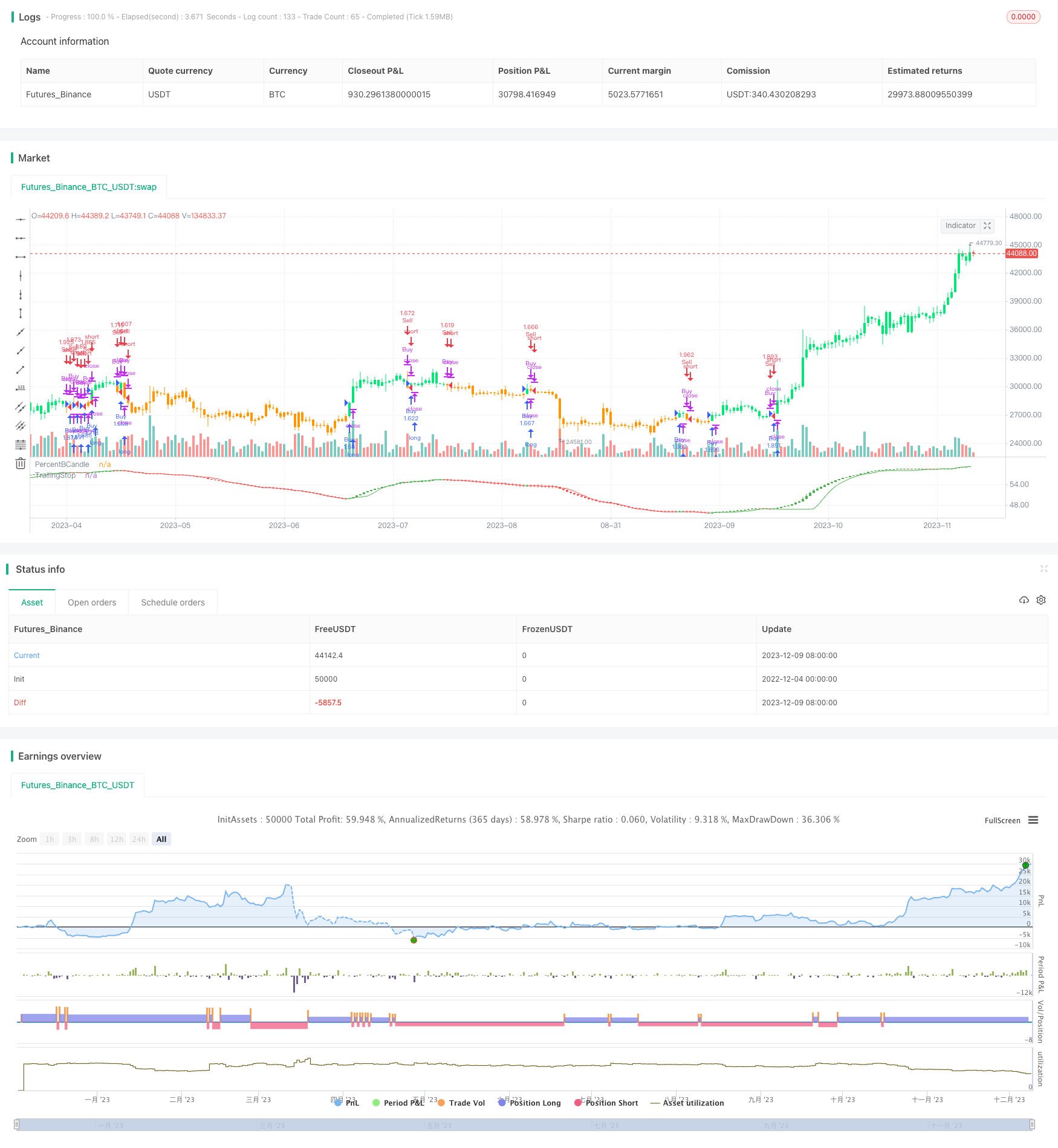
概述
该策略基于布林带指标,结合移动平均线和ATR技术指标,实现了一个短周期的突破系统。策略通过计算布林带通道内价格的相对位置百分比,来判断价格的超买超卖情况,结合新的高低点突破来产生交易信号。
策略原理
- 计算布林带通道及价格在通道内的相对位置百分比
- 对开盘价、收盘价、最高价、最低价分别计算移动平均线
- 计算ATR指标,并结合ATR设定止损线
- 判断价格是否处于新高或新低点附近
- 结合年度最高最低价判断大级别行情
- 通过布林带百分比变化和新高新低判断是否发出交易信号
该策略使用布林带通道判断市场波动率,布林带通道宽度通过标准差确定。价格从布林带下轨突破时为买点,价格从布林带上轨突破时为卖点。移动平均线可平滑布林带波动,减少假突破。ATR指标与移动止损线结合,固定止损幅度。新高新低判断可避免追顶跌破。年度高低判断可排除大级别横盘整理。总体来说,该策略综合运用多种技术分析工具判断市场节奏和入场时机。
策略优势
- 严格的布林带通道突破判断,可减少假信号
- 移动平均线平滑价格,识别真正趋势
- ATR指标动态跟踪止损,可限制单笔损失
- 新高新低和年度高低判断,使信号更可靠
- 多种技术指标有效结合,提高策略效率
策略风险及解决方法
- 布林带通道参数设置不当可能导致过多假突破,应测试不同参数组合以取得最佳效果
- 收盘价为基准线可能出现回撤超过ATR设定的止损幅度,可考虑使用更大波幅的最高最低价计算百分比
- 严格的布林带过滤可能错过较长线上的趋势机会,宜适当放宽过滤条件和持仓时间
- ATR指标较慢跟踪大幅价格波动,应考虑更高频的波动率指标如真实波幅等
- 新高新低突破容易受到短期噪声的干扰,应评估统计显著性和趋势可持续性
策略优化方向
- 测试不同参数组合判断最佳布林带参数和移动平均线长度
- 采用模型组合结合不同布林带参数或移动平均线判断信号
- 测试不同时间段及不同品种参数适配性,提高稳健性
- 结合更多大级别条件判断,如日线级别布林带信号或季节性因素
- 评估趋势跟随型机会,以扩大策略覆盖面和盈利空间
总结
该策略综合运用布林带百分比、移动平均线、ATR指标、新高新低和年度高低等多种技术工具,在短周期上搭建了一个相对严格和高效的突破交易策略。其突出优势在于利用各类工具来减少噪声,识别真正的趋势信号。当然策略也存在一定的参数设定难度和严格条件下错失机会的可能。总体上是一种拥有独特交易风格和突出效率的布林带突破策略,值得进一步研究和基于实盘数据的验证。
策略源码
/*backtest
start: 2022-12-04 00:00:00
end: 2023-12-10 00:00:00
period: 1d
basePeriod: 1h
exchanges: [{"eid":"Futures_Binance","currency":"BTC_USDT"}]
*/
// This source code is subject to the terms of the Mozilla Public License 2.0 at https://mozilla.org/MPL/2.0/
// © HeWhoMustNotBeNamed
//@version=4
strategy("Bollinger %B Candles Strategy", overlay=false, initial_capital = 1000, default_qty_type = strategy.percent_of_equity, default_qty_value = 100, commission_type = strategy.commission.percent, pyramiding = 1, commission_value = 0.01, calc_on_order_fills = true)
BBLength = input(100, minval=1, step=1)
StdDev = 10
useMovingAverage = input(true)
MAType = input(title="Moving Average Type", defval="rma", options=["ema", "sma", "hma", "rma", "vwma", "wma"])
lookbackPeriod = input(22, minval=10, step=10)
colorByPreviousClose = input(true)
AtrMAType = input(title="Moving Average Type", defval="hma", options=["ema", "sma", "hma", "rma", "vwma", "wma"])
AtrLength = input(10)
AtrMult = input(4)
wicks = input(false)
considerYearlyHighLow = input(false)
considerNewLongTermHighLows = input(false)
shortHighLowPeriod = 100
longHighLowPeriod = 200
tradeDirection = input(title="Trade Direction", defval=strategy.direction.all, options=[strategy.direction.all, strategy.direction.long, strategy.direction.short])
backtestYears = input(10, minval=1, step=1)
//////////////////////////////////// Calculate new high low condition //////////////////////////////////////////////////
f_calculateNewHighLows(shortHighLowPeriod, longHighLowPeriod, considerNewLongTermHighLows)=>
newHigh = highest(shortHighLowPeriod) == highest(longHighLowPeriod) or not considerNewLongTermHighLows
newLow = lowest(shortHighLowPeriod) == lowest(longHighLowPeriod) or not considerNewLongTermHighLows
[newHigh,newLow]
//////////////////////////////////// Calculate Yearly High Low //////////////////////////////////////////////////
f_getYearlyHighLowCondition(considerYearlyHighLow)=>
yhigh = security(syminfo.tickerid, '12M', high[1])
ylow = security(syminfo.tickerid, '12M', low[1])
yhighlast = yhigh[365]
ylowlast = ylow[365]
yhighllast = yhigh[2 * 365]
ylowllast = ylow[2 * 365]
yearlyTrendUp = na(yhigh)? true : na(yhighlast)? close > yhigh : na(yhighllast)? close > max(yhigh,yhighlast) : close > max(yhigh, min(yhighlast, yhighllast))
yearlyHighCondition = ( (na(yhigh) or na(yhighlast) ? true : (yhigh > yhighlast) ) and ( na(yhigh) or na(yhighllast) ? true : (yhigh > yhighllast))) or yearlyTrendUp or not considerYearlyHighLow
yearlyTrendDown = na(ylow)? true : na(ylowlast)? close < ylow : na(ylowllast)? close < min(ylow,ylowlast) : close < min(ylow, max(ylowlast, ylowllast))
yearlyLowCondition = ( (na(ylow) or na(ylowlast) ? true : (ylow < ylowlast) ) and ( na(ylow) or na(ylowllast) ? true : (ylow < ylowllast))) or yearlyTrendDown or not considerYearlyHighLow
label_x = time+(60*60*24*1000*1)
[yearlyHighCondition,yearlyLowCondition]
f_getMovingAverage(source, MAType, length)=>
ma = sma(source, length)
if(MAType == "ema")
ma := ema(source,length)
if(MAType == "hma")
ma := hma(source,length)
if(MAType == "rma")
ma := rma(source,length)
if(MAType == "vwma")
ma := vwma(source,length)
if(MAType == "wma")
ma := wma(source,length)
ma
inDateRange = true
[yearlyHighCondition,yearlyLowCondition] = f_getYearlyHighLowCondition(considerYearlyHighLow)
[newHighS,newLowS] = f_calculateNewHighLows(shortHighLowPeriod, longHighLowPeriod, considerNewLongTermHighLows)
[middleclose, upperclose, lowerclose] = bb(close, BBLength, StdDev)
[middleopen, upperopen, loweropen] = bb(open, BBLength, StdDev)
[middlehigh, upperhigh, lowerhigh] = bb(high, BBLength, StdDev)
[middlelow, upperlow, lowerlow] = bb(low, BBLength, StdDev)
percentBClose = (close - lowerclose)*100/(upperclose-lowerclose)
percentBOpen = (open - loweropen)*100/(upperopen-loweropen)
percentBHigh = (high - lowerhigh)*100/(upperhigh-lowerhigh)
percentBLow = (low - lowerlow)*100/(upperlow-lowerlow)
percentBMAClose = f_getMovingAverage(percentBClose, MAType, lookbackPeriod)
percentBMAOpen = f_getMovingAverage(percentBOpen, MAType, lookbackPeriod)
percentBMAHigh = f_getMovingAverage(percentBHigh, MAType, lookbackPeriod)
percentBMALow = f_getMovingAverage(percentBLow, MAType, lookbackPeriod)
newOpen = useMovingAverage? percentBMAOpen : percentBOpen
newClose = useMovingAverage? percentBMAClose : percentBClose
newHigh = useMovingAverage? percentBMAHigh : percentBHigh
newLow = useMovingAverage? percentBMALow : percentBLow
truerange = max(newHigh, newClose[1]) - min(newLow, newClose[1])
averagetruerange = f_getMovingAverage(truerange, AtrMAType, AtrLength)
atr = averagetruerange * AtrMult
longStop = newClose - atr
longStopPrev = nz(longStop[1], longStop)
longStop := (wicks ? newLow[1] : newClose[1]) > longStopPrev ? max(longStop, longStopPrev) : longStop
shortStop = newClose + atr
shortStopPrev = nz(shortStop[1], shortStop)
shortStop := (wicks ? newHigh[1] : newClose[1]) < shortStopPrev ? min(shortStop, shortStopPrev) : shortStop
dir = 1
dir := nz(dir[1], dir)
dir := dir == -1 and (wicks ? newHigh : newClose) > shortStopPrev ? 1 : dir == 1 and (wicks ? newLow : newClose) < longStopPrev ? -1 : dir
trailingStop = dir == 1? longStop : shortStop
candleColor = colorByPreviousClose ?
(newClose[1] < newClose ? color.green : newClose[1] > newClose ? color.red : color.silver) :
(newOpen < newClose ? color.green : newOpen > newClose ? color.red : color.silver)
plotcandle(newOpen, newHigh, newLow, newClose, title='PercentBCandle', color = candleColor, wickcolor=candleColor)
plot(trailingStop, title="TrailingStop", style=plot.style_linebr, linewidth=1, color= dir == 1 ? color.green : color.red)
buyCondition = dir==1 and yearlyHighCondition and newHighS
exitBuyCondition = dir == -1
sellCondition = dir == -1 and yearlyLowCondition and newLowS
exitSellCondition = dir == 1
strategy.risk.allow_entry_in(tradeDirection)
barcolor(buyCondition? color.lime : sellCondition ? color.orange : color.silver)
strategy.entry("Buy", strategy.long, when=buyCondition and inDateRange, oca_name="oca_buy")
strategy.close("Buy", when=exitBuyCondition)
strategy.entry("Sell", strategy.short, when=sellCondition and inDateRange, oca_name="oca_sell")
strategy.close("Sell", when=exitSellCondition)